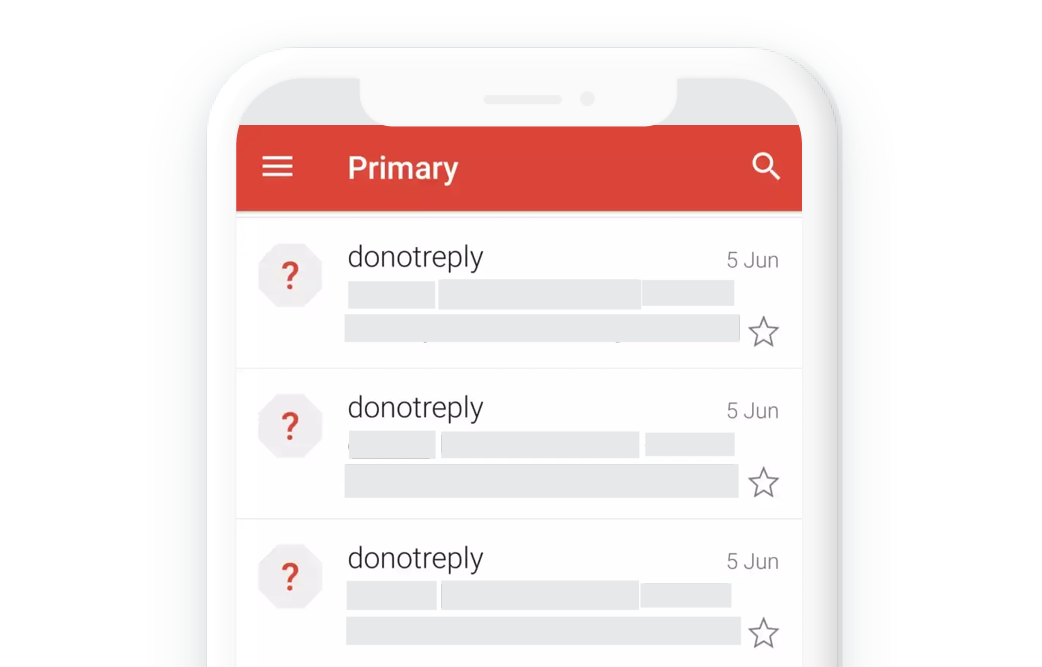Deliverability
Noreply email address: Best practices for your email strategy
Discover what a noreply email address is and the negative impact it can have on your business and your deliverability. Optimize your strategy with these tips.

PUBLISHED ON
Have you ever tried to contact a brand to get them to stop sending you emails, only to receive an automated reply that says your email failed to be delivered? If you have, you’ve met the villain of our story: the noreply email address.
Noreply addresses are the brick wall of digital marketing – no matter how much recipients try to get their message through, there’s just no way to contact the sender.
But what role does this type of address play in an email strategy? In this post, our friend Chris Arrendale, CEO and founder of Inbox Rev, explains what a noreply address is and why sending your marketing emails using a reply-to address is always the best idea.
Table of contents
Product/Service subscription
Terms of service changes
Email/Account verification
Welcome email
Order/Purchase confirmation
It decreases deliverability and increases spam foldering
It can hurt your customer experience
Create a dedicated email address for email responses
Set up filters for specific autoresponders
Keep an eye on the unsubscribes
Build the best conversation
Provide support throughout the customer journey
What is a noreply email address?
A noreply email is an email address that is not monitored and blocks customers from replying. You’ve likely seen this type of sender address before – most of the time it looks like this: noreply@domain.com.
There is a misconception that sending from a noreply email address is the best way to go to avoid being flooded with email replies. Many businesses use this type of email address for receipts or account creation and shipping confirmations. However, it can confuse and frustrate customers if their replies go unanswered or worse – bounce.

Noreply email examples
Still unsure of what a noreply email looks like in your inbox? We’ll highlight a few of the most common examples you’ll likely receive from brands:
Product/Service subscription

Terms of service changes

Email/Account verification

Welcome email

Order/Purchase confirmation

Let’s explore why it’s never a good idea to use a noreply email address for your email marketing campaigns and what you should use instead.
Noreply email addresses generally use the format “noreply@domain.com” and are created to block or discourage recipients from replying to a company’s email campaigns.
Why you shouldn’t use a noreply address in email marketing
While noreply addresses are tempting, there are a few reasons why you shouldn’t use one. Here are the most important things to consider:
It decreases deliverability and increases spam foldering
Certain ISPs, network spam filters, and customers’ personal email security settings are set up to send noreply email to the junk folder. This will decrease your open and overall deliverability rates and will increase your chances of landing in the spam folder. Being inboxed less leads to lower possible conversions, especially when sending blast emails.
Also looking at email trends from a broader sense, 53% of email is opened on mobile devices. To accommodate for the smaller screen, many email clients set their inboxes on mobile devices to just show a preview of the sender and your email address as well. As a consumer, would you open an email with a noreply email address? You’re more likely to feel like a company is unapproachable.
Using a noreply email address can increase spam foldering and hurt your overall email deliverability. If you want to know more about increasing your chances of landing in your subscribers’ inboxes, take a read of our sister company’s, Sinch Mailgun, recently published report The state of email deliverability 2023.
It can hurt your customer experience
When a customer replies to an email, it’s because they have something to share. They could have a support question, a comment about your product or service, or just some constructive feedback that can help a brand with its marketing efforts. Adding your contact information to your email campaigns will help direct some of these comments, but it’s likely many of your customers still opt for just replying to your campaigns. If they get an auto-reply notification telling them the email can’t be delivered, how do you think they��’ll feel?
Post-GDPR, it is also more important than ever to take the time to evaluate whether you should use a no-reply address for your marketing campaigns. How can you expect your subscribers to contact you to claim their rights if you don’t allow them to do so? An autoresponder is just not good enough.
Noreply email addresses lead to a poor customer experience and put you at risk of non GDPR compliance. We recently put together an article on how to conduct an email compliance audit to make sure your email program stays on the right side of the marketing laws.
Swapping out the noreply for a reply-to address
Most ISPs do not allow email recipients to add noreply emails to their address books. If a recipient can’t add you to their address book, you’re more likely to be flagged as spam and sent to the junk folder. It is also much more likely for subscribers to hit the spam button if they can’t reply back requesting removal of their email address. I’ve seen cases where customers unsubscribed from some of their favorite brands because noreply emails addresses were not being monitored.
Another interesting point to remember is that it shows credibility to ISPs when recipients engage with your email, replying to your email being one of those cases. Safe sender privileges include bypassing some of an ISPs mail filters and delivering straight to the inbox.
Best practices when sending email replies
Hopefully, by now you understand the importance of adding a reply-to address to your marketing and transactional emails. To help you implement yours, here are some best practices you should keep in mind.
Create a dedicated email address for email responses
Setting up a dedicated reply-to address will help you filter and follow up on customer feedback. Create an email distro and ensure relevant team members, like support team agents or community managers, have access to the address.
For example, you could set something up like:
hello@company
contact@company
helpdesk@company
information@company
support@company
Sometimes, that dedicated email address might be connected to support software tools like Zendesk, which allow companies to create a generic support email address for incoming support tickets.
If you’ve not set up a custom domain yet, we highly recommend you do so. It improves your sender reputation, builds brand credibility in the inbox, reduces susceptibility to phishing, and helps with email authentication.
However, if you’ve not got around to setting up a custom domain yet and are using a free email provider such as Gmail, this can still be set up easily.
Set up filters for specific autoresponders
We’ve all suffered it. Every company’s reply-to address usually receives an influx of out-of-office messages and other automated responses after a campaign is sent.
To avoid these types of messages clogging your dedicated email address, filter out messages containing keywords such as “delivery notification” or “out of office” in the subject line or body of the email. This will make handling the legitimate messages easier.
Keep an eye on the unsubscribes
As mentioned before, some people skip over the unsubscribe link and reply directly to your email asking to be removed. These customers bypass the unsubscribe link because they’re afraid it will only flood their mailbox with more emails.
Make sure you honor these requests promptly and remove the email addresses from your list. The last thing you want is for these recipients to feel like they are being unheard and in frustration, mark your email as spam.
Also, monitor your reply email address if you’re sending to a domain where the recipient never opted into your email program (something you shouldn’t be doing anyway). The mail administrator (at the recipient’s domain) may try to contact you at your reply email address.
This is a crucial moment because if you don’t respond back, the email recipient may report you to a blocklist and/or try to contact the email service provider (ESP) or data center to complain about your email.

Build the best conversation
A reply-to email address is essential to any email marketing program. It fosters two-way communication and nurtures the conversation between you and your customers.
Many B2B senders will use a sales person’s email address as the reply-to to keep the conversation personal and on a more one-to-one level, while B2C senders may use a general reply-to address that may be monitored by multiple email marketing professionals.
Both scenarios build the confidence that when the recipient replies to the marketing email, the email will be received and followed up on.
Provide support throughout the customer journey
Often, customers reply to emails because they have a support request or concern, or there’s probably something in your email they want to know more about.
When planning your campaigns, think about the kind of questions users might have and proactively offer resources that help answer them.
This will be especially important post-purchase or during the onboarding period. Including links to additional resources, FAQ pages, technical documentation, or your help center will help reduce the number of responses your reply-to address gets and improve your customer experience overall.
Summing up: Say NO to noreply email addresses
To sum it up, the noreply email address should never be used to send from. It tells your customers that you don’t really care what they have to say.
By using a noreply email address, you’re also missing out on an important opportunity to collect feedback and learn how to improve your product and also it’s not the best way to grow your email list.
So now you know: Swap your noreply to a reply-to email address and build a stronger relationship with your recipients.
Want to learn more about email deliverability best practices? Sign up to our newsletter now and get all the tips and tricks in your inbox.
***
This blog post was written by Chris Arrendale, the CEO and Founder of Inbox Pros. Chris has more than 13 years of experience in the technology and software industry and has worked directly with many different ISPs, webmail providers, spam filter providers, blocklists, and partners to resolve email deliverability and privacy issues. He works with many leading organizations and enterprises to ensure regulatory compliance and maximum deliverability across all systems.








